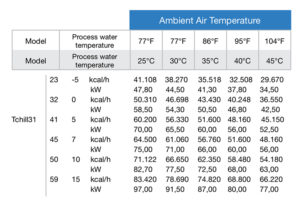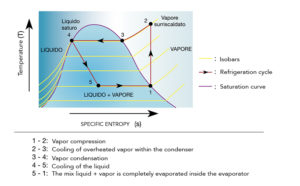

Chillers are refrigerating systems, thermal machines aimed to cool fluids mainly employed in HVAC and conditioning, both for residential and commercial purposes, a commodity very much adopted in private homes and offices during the summer season. Chillers are anyway very widely employed also within industry, used to supply refrigerated water, at very low temperatures, allowing in many applications to reach temperatures much under zero degrees.
For conditioning purposes, direct expansion air conditioning systems with freon are sufficient for small plants, also called split of multisplit. They don’t require to use water (and therefore these are not chillers). Bigger plants require instead more complex solutions, involving also the primary renewal air treatment in addition to the installation of local cooling units, being fan coils fed by chilled water coming from the chillers. Air cooling must also be combined with a dehumidification process of the air, aimed to remove humidity from air which boosts the perception of heat.
At this purpose, conditioning plants served by chillers are fed with inlet water at 7° C (in order to gain a return of 12° C), which is the dew point temperature that generates condensation on fan coil arrays, achieving the air drying process. This drying process also avoid the need to excessively cool air, leading to significant energy savings.
Dehumidification is instead not required in chillers serving industrial processes, where therefore cooling water can be supplied at a slightly higher temperature, for example at 15° C. This allows to employ smaller chillers. Chillers are indeed quite energy consuming thermal machines: hence, aiming to reduce as much as possible energy consume and operating costs, it is best suitable to think sharply and avoid unnecessary wastes. Let’s start with a fact: variations in temperatures and in environmental conditions can lead to very different performances on a chiller.
Selecting a chiller for an industrial production process, the first thing is to evaluate the output temperature of the fluid we need and also the required temperature of the condensing fluid, which can be air or water. The smallest variations in these parameters, being constant the thermal capacity required by the production process, entails sensible variations in the power consumed by the chiller.
Trying to simplify, we can resume it with a scheme: being equal the chilling output, a chiller is smaller, and therefore less power consuming, when it has to supply chilled water at a higher temperature and/or with a lower ambient temperature (that is the condensing temperature). On the opposite, a chiller will be bigger, and thus more power consuming, when being equal the chilling output needed it is aimed to supply colder chilled water and/or with a higher ambient temperature.
The following chart shows the performance variations of a chiller related to variations in ambient air temperature and/or the temperature of the supplied water.

Compressed air chillers works using different types of refrigerant gases, such as freon and ammonia: a volumetric compressor circulates the gas, making it evaporating and condensing, which allows the gas the absorb and dissipate heat. The image below show the typical refrigeration cycle:

Condensation in chillers is achieved using heat exchangers employed as condensers, and can be carried out both with air exchangers or water exchangers.